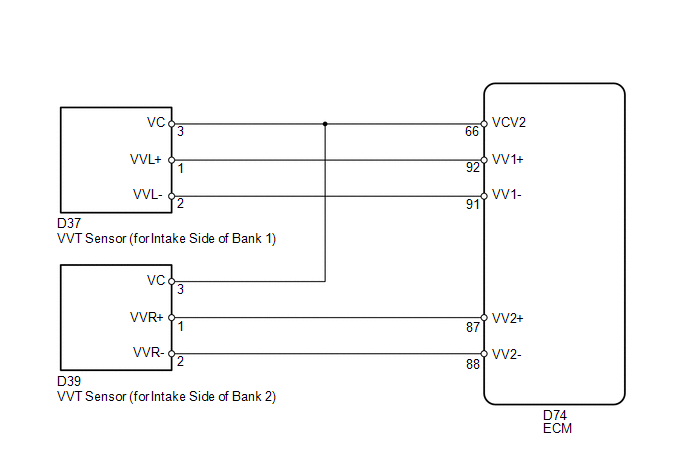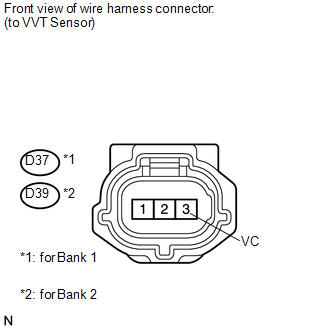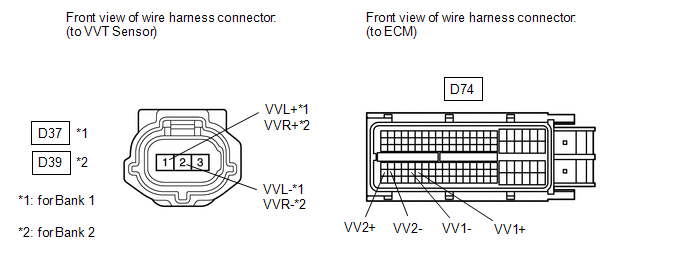DESCRIPTION The intake
camshaft's Variable Valve Timing (VVT) sensor (VV1 and VV2 signal)
consists of a magnet and MRE (Magnetoresistive Element). The
intake camshaft has a sensor plate with 3 teeth on its outer
circumference. When the intake camshaft rotates, changes occur in the
air gaps between the 3 teeth and MRE, which affects the magnet. As a
result, the resistance of the MRE fluctuates. The VVT sensor converts
the gear rotation data into pulse signals, uses the pulse signals to
determine the camshaft angle, and sends it to the ECM. |
DTC No. | DTC Detection Condition |
Trouble Area | | P0340
P0345 | No VVT sensor signal to ECM at engine speed of 600 rpm or more
(1 trip detection logic) |
- Open or short in VVT sensor (for intake side of bank 1, 2) circuit
- VVT sensor (for intake side of bank 1, 2)
- Intake camshaft
- Timing chain for intake camshaft jumped tooth
- ECM
| | P0342
P0347 | Output voltage of VVT sensor less than 0.3 V for 4 seconds
(1 trip detection logic) |
- Open or short in VVT sensor (for intake side of bank 1, 2) circuit
- VVT sensor (for intake side of bank 1, 2)
- Intake camshaft
- Timing chain for intake camshaft jumped tooth
- ECM
| | P0343
P0348 | Output voltage of VVT sensor more than 4.7 V for 4 seconds
(1 trip detection logic) |
- Open or short in VVT sensor (for intake side of bank 1, 2) circuit
- VVT sensor (for intake side of bank 1, 2)
- Intake camshaft
- Timing chain for intake camshaft jumped tooth
- ECM
|
MONITOR DESCRIPTION If
no signal is transmitted by the VVT sensor despite the camshaft
revolving, or the rotations of the camshaft and the crankshaft are not
synchronized, the ECM interprets this as a malfunction of the sensor. When the sensor output voltage remains at less than 0.3 V, or more than 4.7 V for more than 4 seconds, the ECM stores a DTC. MONITOR STRATEGY |
Related DTCs | P0340: VVT position sensor (for Bank 1) verify pulse input
P0342: VVT position sensor (for Bank 1) range check (low voltage) P0343: VVT position sensor (for Bank 1) range check (high voltage)
P0345: VVT position sensor verify pulse input (for Bank 2) P0347: VVT position sensor (for Bank 2) range check (low voltage)
P0348: VVT position sensor (for Bank 2) range check (high voltage) | |
Required Sensors/Components (Main) | VVT position sensor (for Bank 1 and 2) | |
Required Sensors/Components (Related) |
Crankshaft position sensor | |
Frequency of Operation | Continuous | |
Duration | P0340, P0345: 5 seconds
P0342, P0343, P0347, P0348: 4 seconds | |
MIL Operation | Immediate | |
Sequence of Operation | None | TYPICAL ENABLING CONDITIONS P0340, P0345 (Verify pulse input): |
Engine speed | 600 rpm or more | |
Battery voltage | 8 V or higher | |
Starter | OFF | |
Ignition switch | ON | |
Camshaft position sensor voltage | 0.3 to 4.7 V | |
VVT sensor range check low voltage fail (P0342, P0347) |
Not detected | | VVT sensor range check high voltage fail (P0343, P0348) |
Not detected | P0342, P0343, P0347, P0348 (Low voltage, High voltage): |
Starter | OFF | |
Ignition switch | ON | |
Ignition switch ON and time after ignition switch is off to ON |
2 seconds or more | | VVT sensor verify pulse input fail (P0340, P0345) |
Not detected | | Battery voltage |
8 V or Higher | TYPICAL MALFUNCTION THRESHOLDS P0340, P0345 (Verify pulse input): |
VVT sensor signal | No signal | P0342, P0347 (Low voltage): |
VVT sensor voltage | Below 0.3 V | P0343, P0348 (High voltage): |
VVT sensor voltage | Higher than 4.7 V | COMPONENT OPERATING RANGE |
VVT sensor voltage | 0.3 to 4.7 V | CONFIRMATION DRIVING PATTERN
- Connect the Techstream to the DLC3.
- Turn the ignition switch to ON and turn the Techstream on.
- Clear DTCs (even if no DTCs are stored, perform the clear DTC operation).
- Turn the ignition switch off and wait for at least 30 seconds.
- Turn the ignition switch to ON and turn the Techstream on.
- Start the engine.
- Idle the engine for 10 seconds or more [A].
- Enter the following menus: Powertrain / Engine and ECT / Trouble Codes [B].
- Read the pending DTCs.
HINT:
- If a pending DTC is output, the system is malfunctioning.
- If a pending DTC is not output, perform the following procedure.
- Enter the following menus: Powertrain / Engine and ECT / Utility / All Readiness.
- Input the DTC: P0340, P0342, P0343, P0345, P0347 or P0348.
- Check the DTC judgment result.
|
Tester Display |
Description |
|
NORMAL |
- DTC judgment completed
- System normal
|
|
ABNORMAL |
- DTC judgment completed
- System abnormal
|
|
INCOMPLETE |
- DTC judgment not completed
- Perform driving pattern after confirming DTC enabling conditions
|
|
N/A |
- Unable to perform DTC judgment
- Number of DTCs which do not fulfill DTC preconditions has reached ECU memory limit
|
HINT:
If the judgment result shows INCOMPLETE or N/A, perform steps [A] through [B] again.
- If no pending DTC is output, perform a universal trip and check for permanent DTCs (See page
 ). ).
HINT:
- If a permanent DTC is output, the system is malfunctioning.
- If no permanent DTC is output, the system is normal.
WIRING DIAGRAM
 CAUTION / NOTICE / HINT
HINT:
PROCEDURE |
1. | CHECK HARNESS AND CONNECTOR (SENSOR POWER SOURCE) |
 (a) Disconnect the VVT sensor (for intake side) connector.
(b) Measure the voltage according to the value(s) in the table below. Standard Voltage: |
Tester Connection | Condition |
Specified Condition | |
3 (VC) - Body ground |
Ignition switch ON | 4.5 to 5.0 V |
| NG |
 | REPAIR OR REPLACE HARNESS OR CONNECTOR |
|
OK |
 | |
| 2. |
CHECK HARNESS AND CONNECTOR (VVT SENSOR FOR INTAKE SIDE - ECM) |
(a) Disconnect the VVT sensor (for intake side) connector.
 (b) Disconnect the ECM connector.
(c) Measure the resistance according to the value(s) in the table below.
Standard Resistance: |
Tester Connection | Condition |
Specified Condition | |
D37-1 (VVL+) - D74-92 (VV1+) |
Always | Below 1 Ω | |
D37-2 (VVL-) - D74-91 (VV1-) |
Always | Below 1 Ω | |
D39-1 (VVR+) - D74-87 (VV2+) |
Always | Below 1 Ω | |
D39-2 (VVR-) - D74-88 (VV2-) |
Always | Below 1 Ω | |
D37-1 (VVL+) or D74-92 (VV1+) - Body ground |
Always | 10 kΩ or higher | |
D37-2 (VVL-) or D74-91 (VV1-) - Body ground |
Always | 10 kΩ or higher | |
D39-1 (VVR+) or D74-87 (VV2+) - Body ground |
Always | 10 kΩ or higher | |
D39-2 (VVR-) or D74-88 (VV2-) - Body ground |
Always | 10 kΩ or higher |
| NG |
 | REPAIR OR REPLACE HARNESS OR CONNECTOR |
|
OK |
 | |
| 3. |
CHECK SENSOR INSTALLATION (VVT SENSOR FOR INTAKE SIDE) |
| (a) Check the VVT sensor (for intake side) installation. OK:
Sensor is installed correctly. | |
| NG |
 | SECURELY REINSTALL SENSOR |
|
OK |
 | |
| 4. |
INSPECT INTAKE CAMSHAFT (TEETH) | (a) Check the teeth of the camshaft.
OK: Teeth do not have any cracks or deformation. HINT: Perform "Inspection After Repair" after replacing the intake camshaft (See page
 ). ).
| NG |  |
REPLACE INTAKE CAMSHAFT |
|
OK |
 | |
| 5. |
CHECK VALVE TIMING (CHECK FOR LOOSE OR JUMPED TEETH ON TIMING CHAIN) |

| NG |  |
ADJUST VALVE TIMING |
|
OK |
 | |
| 6. |
REPLACE VVT SENSOR (FOR INTAKE SIDE) | (a) Replace the VVT (for intake side) sensor (See page
 ). ).
|
NEXT |
 | |
| 7. |
CHECK WHETHER DTC OUTPUT RECURS | (a) Connect the Techstream to the DLC3.
(b) Turn the ignition switch to ON. (c) Turn the Techstream on.
(d) Clear DTCs. (e) Refer to the confirmation driving pattern. (f) Enter the following menus: Powertrain / Engine and ECT / Trouble Codes / Pending.
(g) Read DTCs. Result |
Result | Proceed to | |
No DTC is output | A | |
P0340, P0342, P0343, P0345, P0347 or P0348 is output |
B | HINT: If the engine does not start, replace the ECM.
| A |
 | END |
| B |
 | REPLACE ECM | |


